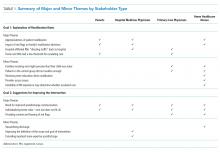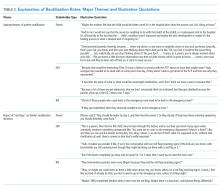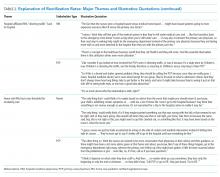A Qualitative Study of Increased Pediatric Reutilization After a Postdischarge Home Nurse Visit
BACKGROUND: The Hospital to Home Outcomes (H2O) trial was a 2-arm, randomized controlled trial that assessed the effects of a nurse home visit after a pediatric hospital discharge. Children randomized to the intervention had higher 30-day postdischarge reutilization rates compared with those with standard discharge. We sought to understand perspectives on why postdischarge home nurse visits resulted in higher reutilization rates and to elicit suggestions on how to improve future interventions.
METHODS: We sought qualitative input using focus groups and interviews from stakeholder groups: parents, primary care physicians (PCP), hospital medicine physicians, and home care registered nurses (RNs). A multidisciplinary team coded and analyzed transcripts using an inductive, iterative approach.
RESULTS: Thirty-three parents participated in interviews. Three focus groups were completed with PCPs (n = 7), 2 with hospital medicine physicians (n = 12), and 2 with RNs (n = 10). Major themes in the explanation of increased reutilization included: appropriateness of patient reutilization; impact of red flags/warning sign instructions on family’s reutilization decisions; hospital-affiliated RNs “directing traffic” back to hospital; and home visit RNs had a low threshold for escalating care. Major themes for improving design of the intervention included: need for improved postdischarge communication; individualizing home visits—one size does not fit all; and providing context and framing of red flags.
CONCLUSION: Stakeholders questioned whether hospital reutilization was appropriate and whether the intervention unintentionally directed patients back to the hospital. Future interventions could individualize the visit to specific needs or diagnoses, enhance postdischarge communication, and better connect patients and home nurses to primary care.
© 2020 Society of Hospital Medicine
RESULTS
A total of 33 parents participated in the interviews (intervention/readmit [8], intervention/no readmit [8], control/readmit [8], and control/no readmit [9]). Although we selected families from all 4 categories, we were not able to explore qualitative differences between these groups because of the relatively low numbers of participants. Parent data was very limited as interviews were brief and “control” parents had not received the intervention. Three focus groups were held with PCPs (7 participants in total), 2 focus groups were held with hospital medicine physicians (12 participants), and 2 focus groups were held with RNs (10 participants).
Goal 1: Explanation of Reutilization Rates
During interviews and focus groups, the results of the H2O trial were discussed, and stakeholders were asked to comment on potential explanations of the findings. 4 major themes and 5 minor themes emerged from analysis of the transcripts (summarized in Table 1).
Theme 1: Appropriateness of Patient Reutilization
Hospital medicine physicians and home care RNs questioned whether the reutilization events were clinically indicated. RNs wondered whether children who reutilized the ED were also readmitted to the hospital; many perceived that if the child was ill enough to be readmitted, then the ED revisit was warranted (Table 2). Parents commented on parental decision-making and changes in clinical status of the child leading to reutilization (Table 2).
Theme 2: Impact of Red Flags/Warning Sign Instructions on Family’s Reutilization Decisions
Theme 3: Hospital-Affiliated RNs “Directing Traffic” Back to Hospital
Both physician groups were concerned that, because the study was conducted by hospital-employed nurses, families might have been more likely to reaccess care at the hospital. Thus, the connection with the hospital was strengthened in the H2O model, potentially at the expense of the connection with PCPs. Physicians hypothesized that families might “still feel part of the medical system,” so families would return to the hospital if there was a problem. PCPs emphasized that there may have been straightforward situations that could have been handled appropriately in the outpatient office (Table 2).
Theme 4: Home Visit RNs Had a Low Threshold for Escalating Care
Parents and PCPs hypothesized that RNs are more conservative and, therefore, would have had a low threshold to refer back to the hospital if there were concerns in the home. One parent commented: “I guess, nurses are just by trade accustomed to erring on the side of caution and medical intervention instead of letting time take its course. … They’re more apt to say it’s better off to go to the hospital and have everything be fine” (Table 2).









